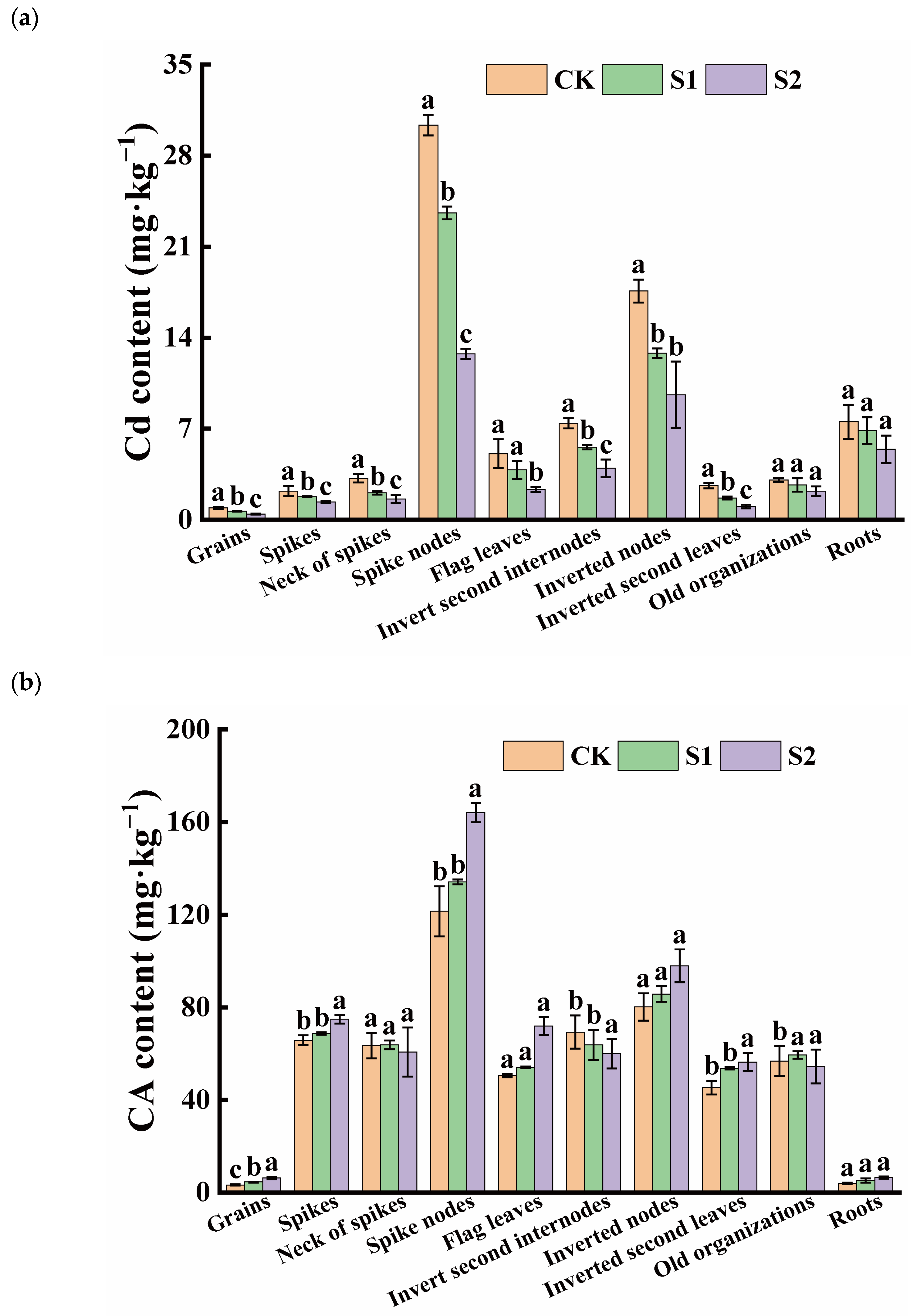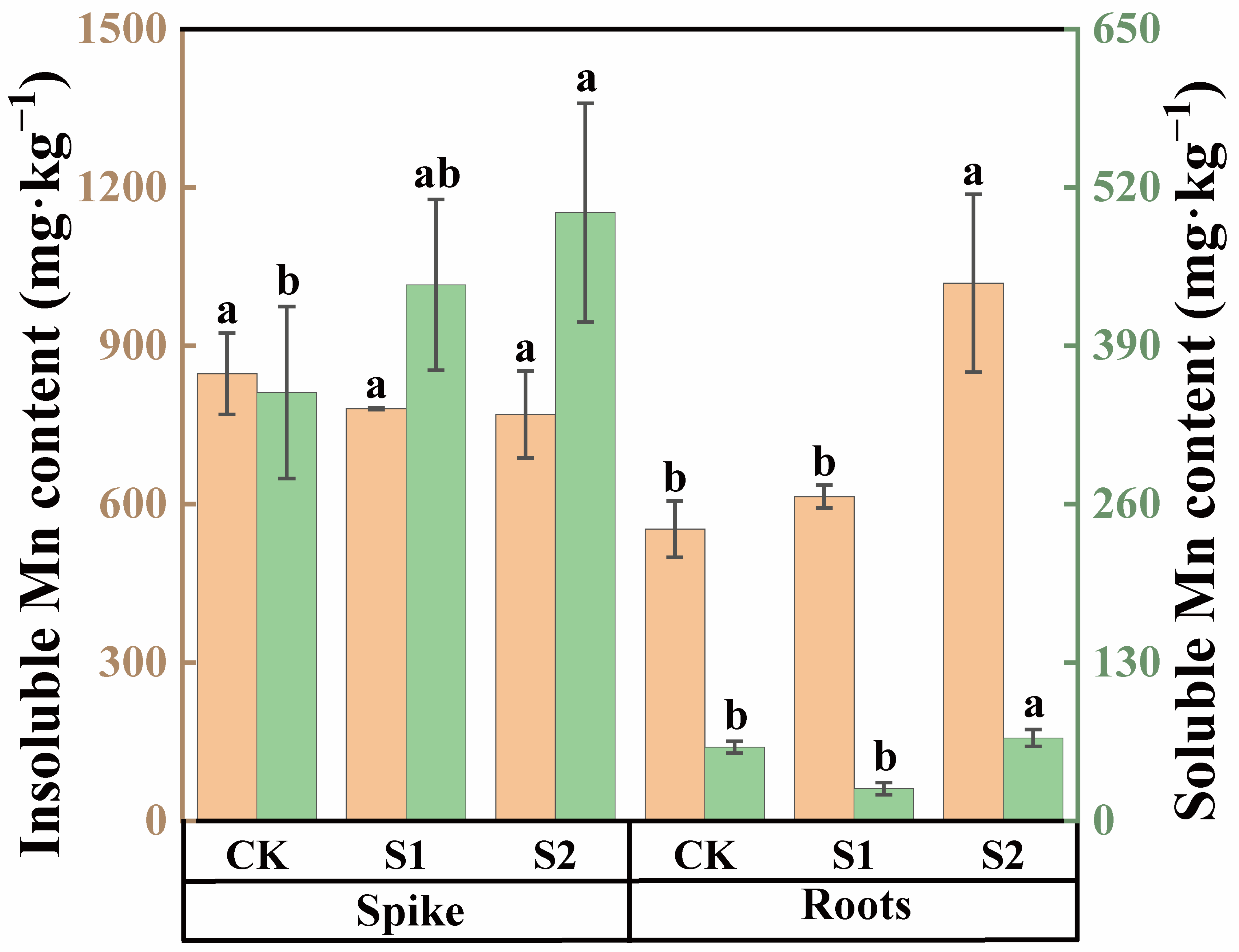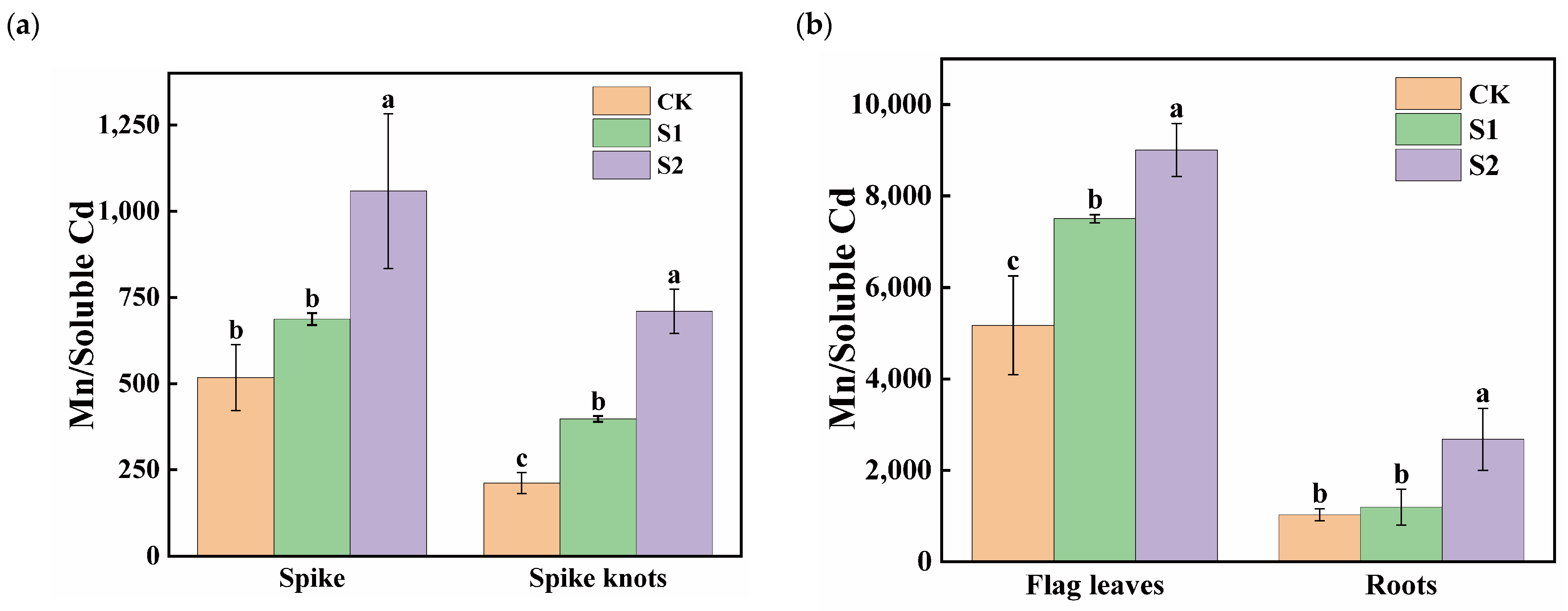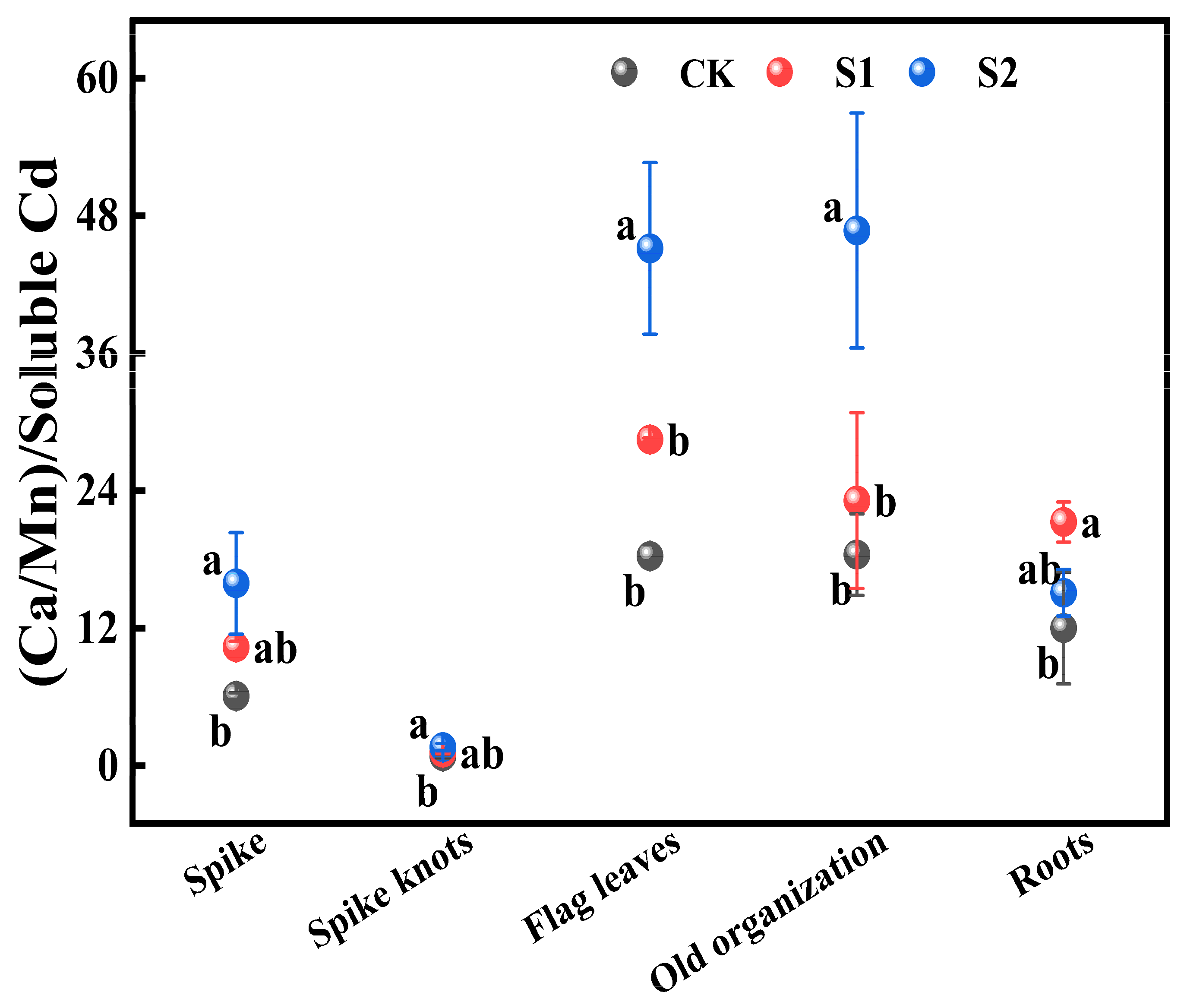Citric Acid Inhibits Cd Absorption and Transportation by Improving the Antagonism of Essential Elements in Rice Organs
Abstract
:1. Introduction
2. Materials and Methods
2.1. Plant Materials and Experimental Site
2.2. Experimental Design and Treatments
2.3. Sample Processed and Collection
2.4. Sample Parameter Determination
2.4.1. Cd and CA Content Determination
2.4.2. Extraction of Cd Speciation
2.4.3. Determination of Mineral Element Content
2.4.4. Transfer Factor Calculation
2.5. Data Analysis
3. Results
3.1. Effects of Leaf Spraying with CA on CA and Cd in Rice Organs
3.1.1. CA and Cd Content and Correlation
3.1.2. Impacts of Foliar Application of CA on the Speciation of Cd in Various Organs of Rice
3.1.3. Effects of CA on Cd Transport between Adjacent Organs in Rice
3.2. Essential Mineral Element in Various Organs of Rice
3.2.1. Effects of Foliar Application of CA on Essential Mineral Element Content in Various Organs of Rice
3.2.2. Effects of Foliar Application of CA on the Speciation of Mn in Rice Spike Knots and Roots
3.3. Effects of Foliar Application of CA on Ion Balance in Key Organs of Rice
3.3.1. Effects of Foliar Application of CA on Mn:Cd Ratios in Different Organs
3.3.2. Effects of Foliar Application of CA on the Ratio (Ca:Mn) to Soluble Cd Ratio in Different Organs
3.4. Correlation Analysis
4. Discussion
4.1. Foliar Application of CA Could Reduce Rice Absorption and Transport of Cd
4.2. Foliar Application of CA Could Alleviate Cd Content by Increasing the Uptake of Mineral Elements and Reducing the Content of Soluble Cd in Different Organs of Rice
4.3. Foliar Application of CA Alleviates Rice Organ Cd Absorption by Modulating Ca:Mn Ratios
5. Conclusions
Author Contributions
Funding
Institutional Review Board Statement
Informed Consent Statement
Data Availability Statement
Acknowledgments
Conflicts of Interest
References
- Zhang, X.; Zhong, T.; Liu, L.; Ouyang, X. Impact of Soil Heavy Metal Pollution on Food Safety in China. PLoS ONE 2015, 10, e0135182. [Google Scholar] [CrossRef]
- Hamid, Y.; Tang, L.; Sohail, M.I.; Cao, X.; Hussain, B.; Aziz, M.Z.; Usman, M.; He, Z.; Yang, X. An Explanation of Soil Amendments to Reduce Cadmium Phytoavailability and Transfer to Food Chain. Sci. Total Environ. 2019, 660, 80–96. [Google Scholar] [CrossRef] [PubMed]
- Ali, H.; Khan, E. What Are Heavy Metals? Long-Standing Controversy over the Scientific Use of the Term ‘Heavy Metals’—Proposal of a Comprehensive Definition. Toxicol. Environ. Chem. 2018, 100, 6–19. [Google Scholar] [CrossRef]
- Li, J.; Xu, Y. Immobilization Remediation of Cd-Polluted Soil with Different Water Condition. J. Environ. Manag. 2017, 193, 607–612. [Google Scholar] [CrossRef] [PubMed]
- Peera Sheikh Kulsum, P.G.; Khanam, R.; Das, S.; Nayak, A.K.; Tack, F.M.G.; Meers, E.; Vithanage, M.; Shahid, M.; Kumar, A.; Chakraborty, S.; et al. A State-of-the-Art Review on Cadmium Uptake, Toxicity, and Tolerance in Rice: From Physiological Response to Remediation Process. Environ. Res. 2023, 220, 115098. [Google Scholar] [CrossRef] [PubMed]
- Riaz, M.; Kamran, M.; Rizwan, M.; Ali, S.; Wang, X. Foliar Application of Silica Sol Alleviates Boron Toxicity in Rice (Oryza sativa) Seedlings. J. Hazard. Mater. 2022, 423, 127175. [Google Scholar] [CrossRef] [PubMed]
- Wang, C.; Rong, H.; Zhang, X.; Shi, W.; Hong, X.; Liu, W.; Cao, T.; Yu, X.; Yu, Q. Effects and Mechanisms of Foliar Application of Silicon and Selenium Composite Sols on Diminishing Cadmium and Lead Translocation and Affiliated Physiological and Biochemical Responses in Hybrid Rice (Oryza sativa L.) Exposed to Cadmium and Lead. Chemosphere 2020, 251, 126347. [Google Scholar] [CrossRef] [PubMed]
- Ehsan, S.; Ali, S.; Noureen, S.; Mahmood, K.; Farid, M.; Ishaque, W.; Shakoor, M.B.; Rizwan, M. Citric Acid Assisted Phytoremediation of Cadmium by Brassica napus L. Ecotoxicol. Environ. Saf. 2014, 106, 164–172. [Google Scholar] [CrossRef] [PubMed]
- Freitas, E.V.; Nascimento, C.W.; Souza, A.; Silva, F.B. Citric Acid-Assisted Phytoextraction of Lead: A Field Experiment. Chemosphere 2013, 92, 213–217. [Google Scholar] [CrossRef]
- Nazari, S.; Rahimi, G.; Khademi Jolgeh Nezhad, A. Effectiveness of Native and Citric Acid-Enriched Biochar of Chickpea Straw in Cd and Pb Sorption in an Acidic Soil. J. Environ. Chem. Eng. 2019, 7, 103064. [Google Scholar] [CrossRef]
- Kibria, M.G.; Barton, L.; Rengel, Z. Applying Foliar Magnesium Enhances Wheat Growth in Acidic Soil by Stimulating Exudation of Malate and Citrate. Plant Soil 2021, 464, 621–634. [Google Scholar] [CrossRef]
- Patra, D.K.; Pradhan, C.; Patra, H.K. Chelate Based Phytoremediation Study for Attenuation of Chromium Toxicity Stress Using Lemongrass: Cymbopogon flexuosus (Nees Ex Steud.) W. Watson. Int. J. Phytoremediation 2018, 20, 1324–1329. [Google Scholar] [CrossRef] [PubMed]
- Ishikawa, S.; Wagatsuma, T.; Sasaki, R.; Ofei-Manu, P. Comparison of the Amount of Citric and Malic Acids in Al Media of Seven Plant Species and Two Cultivars Each in Five Plant Species. Soil Sci. Plant Nutr. 2000, 46, 751–758. [Google Scholar] [CrossRef]
- Zeng, F.; Chen, S.; Miao, Y.; Wu, F.; Zhang, G. Changes of Organic Acid Exudation and Rhizosphere pH in Rice Plants under Chromium Stress. Environ. Pollut. 2008, 155, 284–289. [Google Scholar] [CrossRef]
- Ben Massoud, M.; Sakouhi, L.; Chaoui, A. Effect of Plant Growth Regulators, Calcium and Citric Acid on Copper Toxicity in Pea Seedlings. J. Plant Nutr. 2019, 42, 1230–1242. [Google Scholar] [CrossRef]
- Liu, G.; Meng, J.; Zeng, L.; Liu, X.; Dai, Z.; Tang, C.; Xu, J. Novel Agricultural Waste-Based Materials Decrease the Uptake and Accumulation of Cadmium by Rice (Oryza sativa L.) in Contaminated Paddy Soils. Environ. Pollut. 2021, 289, 117838. [Google Scholar] [CrossRef]
- Sebastian, A.; Prasad, M.N.V. Exogenous Citrate and Malate Alleviate Cadmium Stress in Oryza sativa L.: Probing Role of Cadmium Localization and Iron Nutrition. Ecotoxicol. Environ. Saf. 2018, 166, 215–222. [Google Scholar] [CrossRef] [PubMed]
- Li, F.; Chen, X.; Feng, J.; Liang, Z.; Xu, X.; Ding, T. Ryegrass Extraction of Heavy Metals from Municipal Sewage Sludge Compost-Amended Soils Assisted with Citric Acid. Environ. Sci. Pollut. Res. 2023, 30, 33598–33608. [Google Scholar] [CrossRef]
- Zhang, X.; Zhong, B.; Shafi, M.; Guo, J.; Liu, C.; Guo, H.; Peng, D.; Wang, Y.; Liu, D. Effect of EDTA and Citric Acid on Absorption of Heavy Metals and Growth of Moso Bamboo. Environ. Sci. Pollut. Res. 2018, 25, 18846–18852. [Google Scholar] [CrossRef]
- Xue, W.-J.; Zhang, C.-B.; Wang, P.-P.; Wang, C.-R.; Huang, Y.-C.; Zhang, X.; Liu, Z.-Q. Rice Vegetative Organs Alleviate Cadmium Toxicity by Altering the Chemical Forms of Cadmium and Increasing the Ratio of Calcium to Manganese. Ecotoxicol. Environ. Saf. 2019, 184, 109640. [Google Scholar] [CrossRef]
- Li, S.; Li, G.; Huang, X.; Chen, Y.; Lv, C.; Bai, L.; Zhang, K.; He, H.; Dai, J. Cultivar-Specific Response of Rhizosphere Bacterial Community to Uptake of Cadmium and Mineral Elements in Rice (Oryza sativa L.). Ecotoxicol. Environ. Saf. 2023, 249, 114403. [Google Scholar] [CrossRef]
- Ishimaru, Y.; Takahashi, R.; Bashir, K.; Shimo, H.; Senoura, T.; Sugimoto, K.; Ono, K.; Yano, M.; Ishikawa, S.; Arao, T.; et al. Characterizing the Role of Rice NRAMP5 in Manganese, Iron and Cadmium Transport. Sci. Rep. 2012, 2, 286. [Google Scholar] [CrossRef]
- Carrió-Seguí, A.; Garcia-Molina, A.; Sanz, A.; Peñarrubia, L. Defective Copper Transport in the Copt5 Mutant Affects Cadmium Tolerance. Plant Cell Physiol. 2015, 56, 442–454. [Google Scholar] [CrossRef]
- Cho, S.-C.; Chao, Y.-Y.; Kao, C.H. Calcium Deficiency Increases Cd Toxicity and Ca Is Required for Heat-Shock Induced Cd Tolerance in Rice Seedlings. J. Plant Physiol. 2012, 169, 892–898. [Google Scholar] [CrossRef]
- Chou, T.-S.; Chao, Y.-Y.; Huang, W.-D.; Hong, C.-Y.; Kao, C.H. Effect of Magnesium Deficiency on Antioxidant Status and Cadmium Toxicity in Rice Seedlings. J. Plant Physiol. 2011, 168, 1021–1030. [Google Scholar] [CrossRef] [PubMed]
- Yang, J.; Sun, H.; Qin, J.; Wang, X.; Chen, W. Impacts of Cd on Temporal Dynamics of Nutrient Distribution Pattern of Bletilla Striata, a Traditional Chinese Medicine Plant. Agriculture 2021, 11, 594. [Google Scholar] [CrossRef]
- Xue, W.; Wang, P.; Tang, L.; Zhang, C.; Wang, C.; Huang, Y.; Zhang, X.; Li, Y.; Zhao, B.; Liu, Z. Citric Acid Inhibits Cd Uptake by Improving the Preferential Transport of Mn and Triggering the Defense Response of Amino Acids in Grains. Ecotoxicol. Environ. Saf. 2021, 211, 111921. [Google Scholar] [CrossRef] [PubMed]
- You, S.; Deng, Z.; Chen, M.; Zheng, Y.; Liu, J.; Jiang, P. Mn Pretreatment Improves the Physiological Resistance and Root Exudation of Celosia Argentea Linn. to Cadmium Stress. Int. J. Environ. Res. Public Health 2023, 20, 1065. [Google Scholar] [CrossRef]
- da Silva, J.T.; Paniz, F.P.; Sanchez, F.E.S.; Pedron, T.; Torres, D.P.; da Rocha Concenço, F.I.G.; Barbat Parfitt, J.M.; Batista, B.L. Selected Soil Water Tensions at Phenological Phases and Mineral Content of Trace Elements in Rice Grains—Mitigating Arsenic by Water Management. Agric. Water Manag. 2020, 228, 105884. [Google Scholar] [CrossRef]
- Zhou, H.; Zhu, W.; Yang, W.-T.; Gu, J.-F.; Gao, Z.-X.; Chen, L.-W.; Du, W.-Q.; Zhang, P.; Peng, P.-Q.; Liao, B.-H. Cadmium Uptake, Accumulation, and Remobilization in Iron Plaque and Rice Tissues at Different Growth Stages. Ecotoxicol. Environ. Saf. 2018, 152, 91–97. [Google Scholar] [CrossRef]
- Wang, S.; Wang, F.; Gao, S. Foliar Application with Nano-Silicon Alleviates Cd Toxicity in Rice Seedlings. Environ. Sci. Pollut. Res. Int. 2015, 22, 2837–2845. [Google Scholar] [CrossRef] [PubMed]
- Guo, T.; Wei, J.; Li, X.; Yu, J. Environmental Context of Phenotypic Plasticity in Flowering Time in Sorghum and Rice. J. Exp. Bot. 2024, 75, 1004–1015. [Google Scholar] [CrossRef] [PubMed]
- Ishimaru, T.; Hlaing, K.T.; Oo, Y.M.; Lwin, T.M.; Sasaki, K.; Lumanglas, P.D.; Simon, E.-V.M.; Myint, T.T.; Hairmansis, A.; Susanto, U.; et al. An Early-Morning Flowering Trait in Rice Can Enhance Grain Yield under Heat Stress Field Conditions at Flowering Stage. Field Crops Res. 2022, 277, 108400. [Google Scholar] [CrossRef]
- Zhao, M.; Qian, E.; Zhang, F.; Liu, R.; Liu, X.; Zhao, Y.; Liang, X. Spatiotemporal Dynamics of Labile Cd in Soil during Rice Growth. Sci. Total Environ. 2020, 738, 139832. [Google Scholar] [CrossRef] [PubMed]
- Fu, X.; Dou, C.; Chen, Y.; Chen, X.; Shi, J.; Yu, M.; Xu, J. Subcellular Distribution and Chemical Forms of Cadmium in Phytolacca americana L. J. Hazard. Mater. 2011, 186, 103–107. [Google Scholar] [CrossRef] [PubMed]
- Yang, L.; Zeng, J.; Wang, P.; Zhu, J. Sodium Hydrosulfide Alleviates Cadmium Toxicity by Changing Cadmium Chemical Forms and Increasing the Activities of Antioxidant Enzymes in Salix. Environ. Exp. Bot. 2018, 156, 161–169. [Google Scholar] [CrossRef]
- Gao, M.; Zhou, J.; Liu, H.; Zhang, W.; Hu, Y.; Liang, J.; Zhou, J. Foliar Spraying with Silicon and Selenium Reduces Cadmium Uptake and Mitigates Cadmium Toxicity in Rice. Sci. Total Environ. 2018, 631–632, 1100–1108. [Google Scholar] [CrossRef]
- Xue, W.; Zhang, X.; Zhang, C.; Wang, C.; Huang, Y.; Liu, Z. Mitigating the Toxicity of Reactive Oxygen Species Induced by Cadmium via Restoring Citrate Valve and Improving the Stability of Enzyme Structure in Rice. Chemosphere 2023, 327, 138511. [Google Scholar] [CrossRef]
- DalCorso, G.; Farinati, S.; Furini, A. Regulatory Networks of Cadmium Stress in Plants. Plant Signal. Behav. 2010, 5, 663–667. [Google Scholar] [CrossRef]
- Martinoia, E. Vacuolar Transporters—Companions on a Longtime Journey. Plant Physiol. 2018, 176, 1384–1407. [Google Scholar] [CrossRef]
- Li, B.; Wang, S.; You, X.; Wen, Z.; Huang, G.; Huang, C.; Li, Q.; Chen, K.; Zhao, Y.; Gu, M.; et al. Effect of Foliar Spraying of Gibberellins and Brassinolide on Cadmium Accumulation in Rice. Toxics 2023, 11, 364. [Google Scholar] [CrossRef]
- Ingelmo, F.; Molina, M.J.; Soriano, M.D.; Gallardo, A.; Lapeña, L. Influence of Organic Matter Transformations on the Bioavailability of Heavy Metals in a Sludge Based Compost. J. Environ. Manag. 2012, 95, S104–S109. [Google Scholar] [CrossRef] [PubMed]
- Mugai, E.N.; Agong, S.G.; Matsumoto, H. Aluminium Tolerance Mechanisms in Phaseolus vulgaris L.: Citrate Synthase Activity and TTC Reduction Are Well Correlated with Citrate Secretion. Soil. Sci. Plant Nutr. 2000, 46, 939–950. [Google Scholar] [CrossRef]
- Yang, X.; Wang, C.; Huang, Y.; Liu, B.; Liu, Z.; Huang, Y.; Cheng, L.; Huang, Y.; Zhang, C. Foliar Application of the Sulfhydryl Compound 2,3-Dimercaptosuccinic Acid Inhibits Cadmium, Lead, and Arsenic Accumulation in Rice Grains by Promoting Heavy Metal Immobilization in Flag Leaves. Environ. Pollut. 2021, 285, 117355. [Google Scholar] [CrossRef]
- Ibrahim, E.A. Effect of Citric Acid on Phytoextraction Potential of Cucurbita Pepo, Lagenaria Siceraria, and Raphanus Sativus Plants Exposed to Multi-Metal Stress. Sci. Rep. 2023, 13, 13070. [Google Scholar] [CrossRef] [PubMed]
- Huang, S.; Wang, P.; Yamaji, N.; Ma, J.F. Plant Nutrition for Human Nutrition: Hints from Rice Research and Future Perspectives. Mol. Plant 2020, 13, 825–835. [Google Scholar] [CrossRef]
- Zhu, Y.; Wu, Q.; Lv, H.; Chen, W.; Wang, L.; Shi, S.; Yang, J.; Zhao, P.; Li, Y.; Christopher, R.; et al. Toxicity of Different Forms of Antimony to Rice Plants: Effects on Reactive Oxidative Species Production, Antioxidative Systems, and Uptake of Essential Elements. Environ. Pollut. 2020, 263, 114544. [Google Scholar] [CrossRef] [PubMed]
- Li, P.; Zhao, C.; Zhang, Y.; Wang, X.; Wang, X.; Wang, J.; Wang, F.; Bi, Y. Calcium Alleviates Cadmium-Induced Inhibition on Root Growth by Maintaining Auxin Homeostasis in Arabidopsis Seedlings. Protoplasma 2016, 253, 185–200. [Google Scholar] [CrossRef]
- Chen, R.; Zhang, C.; Zhao, Y.; Huang, Y.; Liu, Z. Foliar Application with Nano-Silicon Reduced Cadmium Accumulation in Grains by Inhibiting Cadmium Translocation in Rice Plants. Environ. Sci. Pollut. Res. 2018, 25, 2361–2368. [Google Scholar] [CrossRef]
- Yamaji, N.; Ma, J.F. Node-Controlled Allocation of Mineral Elements in Poaceae. Curr. Opin. Plant Biol. 2017, 39, 18–24. [Google Scholar] [CrossRef]
- Yamaji, N.; Xia, J.; Mitani-Ueno, N.; Yokosho, K.; Feng Ma, J. Preferential Delivery of Zinc to Developing Tissues in Rice Is Mediated by P-Type Heavy Metal ATPase OsHMA2. Plant Physiol. 2013, 162, 927–939. [Google Scholar] [CrossRef] [PubMed]
- Finkemeier, I.; König, A.-C.; Heard, W.; Nunes-Nesi, A.; Pham, P.A.; Leister, D.; Fernie, A.R.; Sweetlove, L.J. Transcriptomic Analysis of the Role of Carboxylic Acids in Metabolite Signaling in Arabidopsis Leaves. Plant Physiol. 2013, 162, 239–253. [Google Scholar] [CrossRef] [PubMed]
- Ostaszewska, M.; Juszczuk, I.M.; Kołodziejek, I.; Rychter, A.M. Long-Term Sulphur Starvation of Arabidopsis thaliana Modifies Mitochondrial Ultrastructure and Activity and Changes Tissue Energy and Redox Status. J. Plant Physiol. 2014, 171, 549–558. [Google Scholar] [CrossRef]
- Vigani, G.; Briat, J.-F. Impairment of Respiratory Chain under Nutrient Deficiency in Plants: Does It Play a Role in the Regulation of Iron and Sulfur Responsive Genes? Front. Plant Sci. 2015, 6, 1185. [Google Scholar] [CrossRef]
- Coppa, E.; Celletti, S.; Pii, Y.; Mimmo, T.; Cesco, S.; Astolfi, S. Revisiting Fe/S Interplay in Tomato: A Split-Root Approach to Study the Systemic and Local Responses. Plant Sci. 2018, 276, 134–142. [Google Scholar] [CrossRef]
- McKay Fletcher, D.M.; Shaw, R.; Sánchez-Rodríguez, A.R.; Daly, K.R.; van Veelen, A.; Jones, D.L.; Roose, T. Quantifying Citrate-Enhanced Phosphate Root Uptake Using Microdialysis. Plant Soil. 2021, 461, 69–89. [Google Scholar] [CrossRef] [PubMed]
- Tahjib-Ul-Arif, M.; Zahan, M.I.; Karim, M.M.; Imran, S.; Hunter, C.T.; Islam, M.S.; Mia, M.A.; Hannan, M.A.; Rhaman, M.S.; Hossain, M.A.; et al. Citric Acid-Mediated Abiotic Stress Tolerance in Plants. Int. J. Mol. Sci. 2021, 22, 7235. [Google Scholar] [CrossRef]
- Liu, Y.; Zhang, C.; Zhao, Y.; Sun, S.; Liu, Z. Effects of Growing Seasons and Genotypes on the Accumulation of Cadmium and Mineral Nutrients in Rice Grown in Cadmium Contaminated Soil. Sci. Total Environ. 2017, 579, 1282–1288. [Google Scholar] [CrossRef]
- Zhao, P.; Huang, P.; Yan, X.; Chukwuma, A.; Yang, S.; Yang, Z.; Li, H.; Yang, W. Inhibitory Effect of Exogenous Mineral Elements (Si, P, Zn, Ca, Mn, Se, Fe, S) on Rice Cd Accumulation and Soil Cd Bioavailability in Cd-Contaminated Farmlands: A Meta-Analysis. Chemosphere 2023, 343, 140282. [Google Scholar] [CrossRef]
- Tang, L.; Mao, B.; Li, Y.; Lv, Q.; Zhang, L.; Chen, C.; He, H.; Wang, W.; Zeng, X.; Shao, Y.; et al. Knockout of OsNramp5 Using the CRISPR/Cas9 System Produces Low Cd-Accumulating Indica Rice without Compromising Yield. Sci. Rep. 2017, 7, 14438. [Google Scholar] [CrossRef]







| Organ of Rice | Grain | Spike | Neck of Spike | Spike Knots | Flag Leaf | Inverted Two Internodes | Inverted Node | Inverted Two Leaves | Others | Root |
|---|---|---|---|---|---|---|---|---|---|---|
| Grains | 0.90 ** | —— | 0.94 ** | 0.96 ** | —— | 0.85 ** | 0.84 ** | —— | 0.93 ** | |
| Spikes | 0.89 ** | —— | 0.93 ** | 0.89 ** | —— | 0.80 * | 0.81 ** | —— | 0.88 ** | |
| Neck of spikes | 0.84 ** | 0.79 * | —— | —— | —— | —— | —— | 0.88 ** | —— | |
| Spike nodes | 0.97 ** | 0.88 ** | 0.90 ** | 0.95 ** | —— | 0.80 ** | 0.82 ** | —— | 0.92 ** | |
| Flag leaves | 0.77 * | 0.67 * | 0.92 ** | 0.85 ** | —— | 0.84 ** | 0.75 * | —— | 0.88 ** | |
| Inverted second internodes | 0.98 ** | 0.85 ** | 0.87 ** | 0.99 ** | 0.81 ** | —— | —— | —— | —— | |
| Inverted nodes | 0.95 ** | 0.77 * | 0.78 * | 0.93 ** | 0.67 * | 0.96 ** | —— | —— | 0.88 ** | |
| Inverted second leaves | 0.93 ** | 0.88 ** | 0.95 ** | 0.96 ** | 0.91 ** | 0.95 ** | 0.84 ** | —— | 0.79 * | |
| Others | 0.78 * | —— | 0.71 * | 0.85 ** | 0.58 | 0.87 ** | 0.89 ** | 0.76 * | —— | |
| Roots | —— | 0.70 * | —— | 0.72 * | 0.77 * | 0.71 * | —— | 0.81 ** | —— | |
| Cd/CA in the same organ | −0.92 | −0.89 | —— | −0.94 | −0.81 | —— | −0.87 | −0.86 | —— | −0.77 |
| TF Grain/Spike | TF Spike/SK | TF SK/FL | TF ITI/IN | TF IN/ITL | TF ITL/OO | TF OO/Roots | |
|---|---|---|---|---|---|---|---|
| CK | 1.3 ± 0.1 a | 0.4 ± 0.1 a | 141.1 ± 17.7 a | 2.5 ± 0.3 a | 245.2 ± 44.2 a | 8.7 ± 2.3 a | 5.0 ± 0.3 a |
| S1 | 1.4 ± 0.1 a | 0.5 ± 0.1 a | 157.7 ± 36.4 a | 3.0 ± 0.9 a | 155.7 ± 33.3 b | 6.5 ± 1.5 a | 6.8 ± 2.9 a |
| S2 | 1.4 ± 0.3 a | 0.6 ± 0.1 a | 100.5 ± 13.2 b | 2.7 ± 0.7 a | 151.9 ± 20.6 b | 5.6 ± 1.9 a | 6.3 ± 2.0 a |
| Organ | Treatment | K (g·kg−1) | Ca (g·kg−1) | Mg (g·kg−1) | Mn (g·kg−1) | Fe (g·kg−1) | Zn (g·kg−1) |
|---|---|---|---|---|---|---|---|
| Grains | CK | 0.87 ± 0.03 b | 0.57 ± 0.05 a | 0.32 ± 0.01 c | 0.02 ± 0 b | 0.02 ± 0 a | 0.02 ± 0 a |
| S1 | 1.04 ± 0.21 b | 0.45 ± 0.02 b | 0.48 ± 0.05 b | 0.02 ± 0 ab | 0.02 ± 0 a | 0.02 ± 0 b | |
| S2 | 1.27 ± 0.05 a | 0.44 ± 0.02 b | 0.57 ± 0.03 a | 0.02 ± 0 a | 0.02 ± 0 a | 0.02 ± 0 b | |
| Spikes | CK | 21.08 ± 1.29 b | 1.74 ± 0.05 a | 1 ± 0.07 a | 0.38 ± 0.03 a | 0.13 ± 0.02 b | 0.06 ± 0.01 a |
| S1 | 26.44 ± 0.8 a | 1.85 ± 0.37 a | 1.06 ± 0.11 a | 0.35 ± 0.05 a | 0.27 ± 0.02 a | 0.07 ± 0.01 a | |
| S2 | 24.761.05 a | 2.12 ± 0.22 a | 1.05 ± 0.08 a | 0.38 ± 0.03 a | 0.36 ± 0.07 a | 0.08 ± 0.01 a | |
| Spike nodes | CK | 133.92 ± 15.42 a | 7.92 ± 0.43 a | 5.85 ± 0.89 a | 1.42 ± 0.06 b | 1.24 ± 0.09 a | 1.37 ± 0.06 a |
| S1 | 139.2 ± 26.8 a | 7.56 ± 0.24 a | 5.42 ± 0.22 a | 1.62 ± 0.11 ab | 1.44 ± 0.12 a | 1.19 ± 0.1 b | |
| S2 | 128.76 ± 13.93 a | 7.03 ± 0.64 a | 4.99 ± 0.49 a | 1.76 ± 0.20 a | 1.48 ± 0.25 a | 1.14 ± 0.01 b | |
| Flag leaves | CK | 19.32 ± 1.82 a | 5.64 ± 0.26 a | 2.38 ± 0.41 a | 1.26 ± 0.18 a | 0.29 ± 0.03 a | 0.05 ± 0.01 a |
| S1 | 21.49 ± 2.68 a | 6.17 ± 0.88 a | 2.46 ± 0.37 a | 1.27 ± 0.08 a | 0.33 ± 0.05 a | 0.05 ± 0.01 a | |
| S2 | 20.28 ± 2.27 a | 6.48 ± 0.71 a | 2.41 ± 0.45 a | 1.14 ± 0.1 a | 0.4 ± 0.06 a | 0.06 ± 0.01 a | |
| Others | CK | 33.47 ± 0.63 a | 6.91 ± 0.8 a | 2.51 ± 0.2 a | 1.13 ± 0.08 a | 0.67 ± 0.05 a | 0.1 ± 0.01 a |
| S1 | 34.02 ± 0.16 a | 7.19 ± 0.15 a | 2.44 ± 0.03 a | 1.15 ± 0.04 a | 0.84 ± 0.07 a | 0.09 ± 0.01 a | |
| S2 | 31.76 ± 4.82 a | 7.15 ± 1.13 a | 2.44 ± 0.16 a | 0.93 ± 0.1 b | 0.87 ± 0.16 a | 0.08 ± 0.01 a | |
| Roots | CK | 6.55 ± 1.11 a | 4.78 ± 0.73 a | 1.15 ± 0.19 a | 0.66 ± 0.12 b | 75.78 ± 6.55 a | 0.1 ± 0.02 a |
| S1 | 7.61 ± 1.7 a | 4.67 ± 0.07 a | 1.19 ± 0.02 a | 0.51 ± 0.07 b | 67.09 ± 12.85 a | 0.09 ± 0.01 a | |
| S2 | 5.86 ± 1.4 a | 5.65 ± 0.81 a | 1.24 ± 0.21 a | 0.99 ± 0.06 a | 81.42 ± 13.11 a | 0.11 ± 0.02 a |
Disclaimer/Publisher’s Note: The statements, opinions and data contained in all publications are solely those of the individual author(s) and contributor(s) and not of MDPI and/or the editor(s). MDPI and/or the editor(s) disclaim responsibility for any injury to people or property resulting from any ideas, methods, instructions or products referred to in the content. |
© 2024 by the authors. Licensee MDPI, Basel, Switzerland. This article is an open access article distributed under the terms and conditions of the Creative Commons Attribution (CC BY) license (https://creativecommons.org/licenses/by/4.0/).
Share and Cite
Chen, K.; Yu, B.; Xue, W.; Sun, Y.; Zhang, C.; Gao, X.; Zhou, X.; Deng, Y.; Yang, J.; Zhang, B. Citric Acid Inhibits Cd Absorption and Transportation by Improving the Antagonism of Essential Elements in Rice Organs. Toxics 2024, 12, 431. https://doi.org/10.3390/toxics12060431
Chen K, Yu B, Xue W, Sun Y, Zhang C, Gao X, Zhou X, Deng Y, Yang J, Zhang B. Citric Acid Inhibits Cd Absorption and Transportation by Improving the Antagonism of Essential Elements in Rice Organs. Toxics. 2024; 12(6):431. https://doi.org/10.3390/toxics12060431
Chicago/Turabian StyleChen, Kexin, Bozhen Yu, Weijie Xue, Yuebing Sun, Changbo Zhang, Xusheng Gao, Xiaojia Zhou, Yun Deng, Jiarun Yang, and Boqian Zhang. 2024. "Citric Acid Inhibits Cd Absorption and Transportation by Improving the Antagonism of Essential Elements in Rice Organs" Toxics 12, no. 6: 431. https://doi.org/10.3390/toxics12060431






